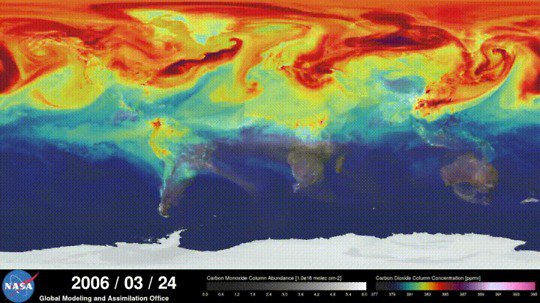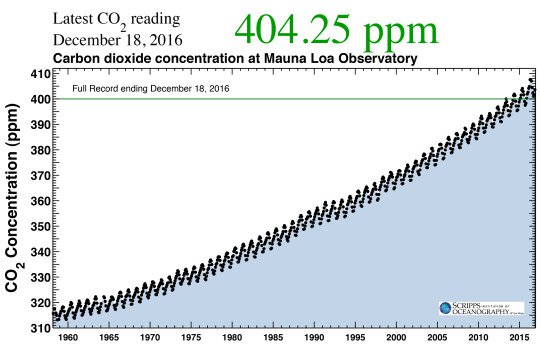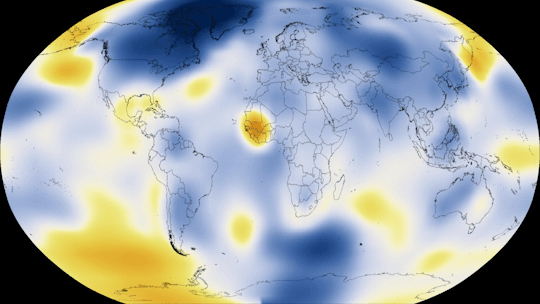2016 Top 5 Earth Science Breakthroughs
2016 was truly a banner year for climate-related Earth science news and scientific discoveries. Here we’ll explore just a few of the top Earth science news stories from the year.
5: Renewable energy surpasses coal as world’s leading source of energy capacity.
Based on data collected during 2015, the International Energy Agency (IEA) released a report in October 2016 that significantly increased their previous five-year growth forecast for renewable energy worldwide, in part due to ongoing policy support in key countries like China, the US, India, and Mexico, and significant reductions in cost. By 2021, the IEA sees renewables growing at least 13% faster worldwide and their share of the world’s energy generation increasing to nearly 30%. This remarkable growth is echoed by the fact that renewables are currently beating fossil fuels 2 to 1 in new investments in power capacity worldwide, and the solar and wind industries have septupled and quadrupled in size since 2000, respectively.
According to the report, 2015 marked a major turning point for renewables – they officially surpassed coal to become the largest source of global electricity capacity. In 2015, about 500,000 solar panels were being installed every day around the world, and China alone was installing nearly 2 wind turbines every hour. Given these trajectories, the IEA estimates that over the next five years, 2.5 wind turbines and 30,000 solar panels will be installed every hour. While these figures are encouraging, the share of renewables in heat and transport energy is markedly lagging, only expected to make up around 10% of heat and 4% of transportation energy generation by 2021, respectively.
This accelerated growth of the renewable industry is certainly promising news for putting the world’s nations on a clear path toward meeting long-term climate change and resiliency goals.
Read more at https://www.iea.org/newsroom/news/2016/october/iea-raises-its-five-year-renewable-growth-forecast-as-2015-marks-record-year.html and https://www.bloomberg.com/news/articles/2016-04-06/wind-and-solar-are-crushing-fossil-fuels.
4: Human activities outpace natural emissions of heat-trapping gases over the last 66 million years.

Zeebe et al., Nature Geoscience 9, 325–329 (2016) doi:10.1038/ngeo2681A study published in March 2016 in the journal Nature Geoscience found that humans are currently releasing heat-trapping gases like carbon dioxide and methane around 10 times faster than the Earth did naturally over the last 66 millon years. Yes, you read that right: 66 MILLION years.
Using ancient sediments collected from off of the coast of Millville, New Jersey, researchers examined the changing chemistry of the sedimentary layers to understand large-scale changes in the Earth’s carbon cycle and climate during the Paleocene-Eocene Thermal Maximum (PETM), or a period of Earth’s history about 56 million years ago.
The PETM was a time of intense global warming that increased global temperatures by ~7-14°F, and was accompanied by a mass extinction of marine life throughout the global ocean. For many years, scientists have been able to link the PETM’s substantial global warming to a massive release of heat-trapping gases into the atmosphere. However, scientists have been puzzled by just how quickly heat-trapping gases were released during the PETM and how that might compare to present human emissions of heat-trapping gases, until now.
By measuring incremental deviations in the carbon and oxygen isotope signatures of these sedimentary layers heading into and during the PETM, the team of researchers then used sophisticated computer technology to estimate the rate at which heat-trapping gases were released during the PETM. Because sedimentary carbon and oxygen isotope signatures are sensitive to changes in the heat-trapping gas concentration of the atmosphere and the temperature of the ocean, respectively, the team of researchers were able to fingerprint the rate of heat-trapping gas release during the PETM for the first time.
Their findings pinned down the maximum rate of heat-trapping gas release during the PETM to be at most ~1.1 Petagrams of carbon per year (PgC/year). In a sense, this estimates Earth’s natural heat-trapping gas “speed limit” that has endured over the last 66 million years. However, anthropogenic (that is, human-caused) emissions of heat-trapping gases reached ~10 PgC/year in 2014, exceeding Earth’s natural heat-trapping gas emission “speed limit” by a factor of ten. In other words, the Earth naturally released heat-trapping gases during the PETM at a rate comparable to an interstate speed limit (~76mph) while humans are now releasing heat-trapping gases at the speed of sound (~760mph).
Read more in the article published in Nature Geoscience.
3: Paris Climate Agreement reaches landmark threshold for entry October 2016, goes into force Nov 2016.
On October 5th, 2016, a global threshold was passed. 73 countries constituting at least 55% of the world’s heat-trapping gas emissions submitted plans for implementing the landmark United Nations Framework Convention on Climate Change (UNFCCC) Paris Agreement. One month later, the Paris Agreement became international law.
The Paris Agreement, the world’s first international policy agreement aimed at mitigating the effects of human-caused climate change, was formally adopted by all 196 countries (called “Parties”) in the UNFCCC at the COP21 meeting in Paris on December 12th, 2015. The Paris Agreement states that all countries that adopted the Agreement will work to limit global temperature rise to below 2 degrees Celsius, with the more ambitious goal to limit global warming to 1.5 degrees Celsius. The Paris Agreement thus requires substantial and increasingly ambitious reductions in the emissions of heat-trapping gases worldwide, along with plans to keep future development sustainable, carbon low-to-neutral, and energy-efficient.
The Paris Agreement fulfills just one of 17 of the UN’s Sustainable Development Goals – Climate Action – which seeks to strengthen community and national resilience to climate-related hazards and disasters, provide sustainable options for countries that will be developing in the near future, and integrating climate change preparedness and measures into national strategic planning.With more than 6,000 cities already on pace to surpass their emissions targets by 2020, there’s plenty of momentum worldwide to suggest that the Paris Agreement’s unifying message has resonated around the world.
Read more at http://unfccc.int/paris_agreement/items/9444.php and https://www.theguardian.com/environment/2016/nov/04/paris-climate-change-agreement-enters-into-force.

2: Heat-trapping carbon dioxide levels exceed 400 ppm for the first time in at least 800,000 years, and permanently for at least our lifetimes.
At the famous Mauna Loa Observatory in Hawaii September 2016, when the level of the heat-trapping gas carbon dioxide usually dips to its lowest value during the year, carbon dioxide levels didn’t go below 400 ppm for the first time in at least 800,000 years…and probably won’t go below 400 ppm again within our lifetimes.
The heat-trapping gas, carbon dioxide, gets pulled out of the atmosphere when plants in the Northern Hemisphere grow throughout the spring and summer. When they die and decompose in the fall and winter, that carbon dioxide is returned to the atmosphere. Think of this natural process like the Earth’s seasonal breathing.
However, because of human combustion of fossil fuels like coal, oil, and natural gas, the background level of heat-trapping gases like carbon dioxide has steadily increased since the industrial revolution and has now reached levels the Earth has not experienced in at least the last 800,000 years, and very likely millions of years.
Because carbon dioxide remains in our atmosphere for decades to centuries, and its impacts on our climate system such as global warming and global sea-level rise will continue to play out for hundreds to thousands of years, humankind may well remember September 2016 as one of the most significant milestones in Earth’s climate history.
Ralph Keeling, program director of the Scripps CO2 Program and son of the late visionary scientist Charles David Keeling who started the carbon dioxide observatory on Mauna Loa in 1958, put passing this planetary threshold into perspective on Sept. 23, 2016: “Brief excursions towards lower values [of carbon dioxide] are still possible [in the coming months] but it already seems safe to conclude that we won’t be seeing a monthly value [of carbon dioxide] below 400 ppm this year – or ever again for the indefinite future.”
Read more at https://scripps.ucsd.edu/programs/keelingcurve/2016/09/23/note-on-reaching-the-annual-low-point/.
1: The Big Story: Global Temperatures & Arctic Sea Ice

In 2016, Earth experienced the strongest El Niño event of the last 18 years, likely extending the string of record warmth we experienced in 2015 into a 16-month run of record high monthly global average temperatures. This streak of anomalously warm global temperatures was finally broken in September 2016, which was only the 2nd warmest September since we began measuring the Earth’s temperature about 137 years ago. So far, 2016 is clearly the warmest year-to-date in the 137 years of NOAA observational data. And, many climatologists expect 2016 to smash the current yearly global average temperature record set in 2015, even with the advent of a weak La Nina arriving this winter.
In related news, Arctic sea ice set a number of records this year. This winter saw Arctic sea ice grow to a record low maximum extent since satellite records began in 1979, defeating the previous low maximum extent record set in 2015. Arctic sea ice then reached its 2nd lowest extent at the end of the summer in September 2016, and has since exhibited extreme low extents throughout November 2016. This is partially due to abnormal warmth in the Arctic circle, with average temperatures reaching close to 30°F above normal for this time of year, when Arctic sea ice is usually rapidly expanding.
Read more at https://www.ncdc.noaa.gov/sotc/.